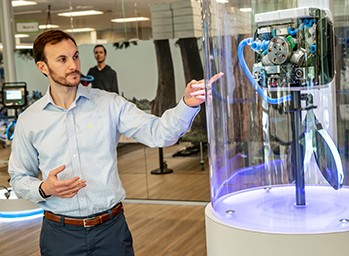
Living and Breathing Engineering
For most people, breathing happens without thinking. But for people who need help breathing, a ventilator is a device they can’t live without.
From Friday, April 19th (11:00 PM CDT) through Saturday, April 20th (2:00 PM CDT), 2024, ni.com will undergo system upgrades that may result in temporary service interruption.
We appreciate your patience as we improve our online experience.

As I write this, I’m at home. I’m working, but instead of sitting in close proximity to my coworkers, near whiteboards and equipment, I spend many hours a day in virtual meetings. Fortunately, like many others who are now working remotely, I have access to tools that allow me to remain productive, collaborate and communicate. In the world of engineering, the necessity of remote access to maintain productivity is not new but leveraging remote access to increase productivity is trending upward. Not only is this increased productivity possible, it’s vital.
I’d like to call attention to four factors needed to increase productivity. As it turns out, these four factors are also the obstacles that have historically decreased or prevented productivity. These four are safety, time, distance and expertise. Let’s take a look at each one.
In the world of engineering, the necessity of remote access to maintain productivity is not new but leveraging remote access to increase productivity is trending upward. Not only is this increased productivity possible, it’s vital.
Safety. COVID-19 has confronted us with safety-related health obstacles. As we look to COVID-19 recovery, greater access to engineering tools is needed to help us return to normal — or perhaps transition to a new normal — quickly. However, when it comes to test, health safety is not exclusive to COVID-19 as there are many cases where the tests and measurements needed to design and produce reliable technology are recorded in unsafe environments. Toxic gases, risk of explosion, extreme heat and cold — just to name of few — are dangers that may be present. The ability to access the tests, pull data and make iterations in unsafe environments remotely increases the health and safety of the engineers involved.
Time. When looking at the technology that is critical for humanity’s safety and survival, time is a luxury that we do not have. The backlog of inventions and prototypes not yet ready for deployment grows longer each day. But what if I told you, you could finish a job in six weeks that you had scheduled for six months? What is the first thing that comes to mind? One thought is that you will be finished earlier than scheduled, thus resulting in time saved. However, time saved can also be used as ample time to further test, further analyze, further refine and turn nice-to-haves into need-to-haves, all while staying on schedule.
Distance. In the Internet age, we have eliminated the obstacle of physical distance. However, we’re not talking solely about communication; we’re also talking about control, iteration and decision making — not just looking at data but making test iteration and control decisions based on the data. Turning a knob on an instrument via the Internet is possible, but it’s not always an option in all instances and industries, although it should be. A good example is a landscape covered with wind turbines. Monitoring the operational efficiency of each turbine typically would require someone to physically drive to each one. This would be a daunting task that would take an enormous amount of time.
Expertise. Experts are in high demand because expertise isn’t everywhere. Typically, any organization’s group of experts must determine where they focus their time based on distance. Yes, expertise is not only reliant on the availability of experts but also on time and distance. However, an increase in the number of, or availability of, experts is not as necessary if we can eliminate the obstacles of time and distance on behalf of our experts. Experts now able to distribute their experience and skills across a broader spectrum and in exponentially less time is a game changer.
Remote monitoring was not always possible. Today, it is a must.
These factors when grouped together in different ways, can either open new doors or shut them all together. Therefore, we must ensure that the relationship between these factors results in an increase — versus a drop — in efficiency.
Efficiency is key to ensuring reliable, accessible and affordable technology around the world. Here we are talking about efficiency in manufacturing. And for manufacturing automation, this is an evolution.
In the not-so-distant future, factories will be able to operate “lights out.” That is, improved processes will allow humans to interface at a safe distance — at any distance — and ensure experts have equal access to all aspects of the operation.
A few years ago, Franck Choplain, the digital industry director of Thales, said, “It will soon become standard that our customers require the management and maintenance of test assets from around the world. We must reshape our test architectures to integrate IoT technologies, especially to evolve configuration management and data analytics and support the digitalization of our business for Industry 4.0.” Well, here we are. This has become true.
NI and the companies we serve are ahead of the curve. Enterprise software is a critical facilitator of this transformation and trend. To be product specific, NI’s SystemLink™ software is an intelligent systems and data management platform for validation, production and monitoring test environments.
SystemLink software eliminates manual tasks when keeping test systems current and healthy. Leveraging an automation and connectivity platform, this software aggregates test and measurement data from all test systems into a centralized data repository. This means experts have access to asset utilization, calibration forecasts, test result history, trends and production metrics data to make proactive decisions on the capital expense, maintenance events and test or product modifications.
Ian Yeager, a test engineering manager at CREE Lighting shared their love of SystemLink in how “it enables our production floor to step into the future of doing business. We keep approaching a ‘new normal’ every day and SystemLink enables us to visualize what the new normal looks like for teams supporting development and production efforts all around the world.”
Leveraging data at scale helps teams and enterprises adjust and boost productivity in their new normal.
Time is the everlasting juggernaut. We cannot change time, but we can accelerate our process. And we can make better use of the time we have. Consider this example of a manufacturer of luxury appliances known for their quality and dependability.
With appliances designed and tested to last a minimum of 20 years, test is a vital part of their manufacturing process. Every major function of every unit is tested before shipping. To meet these demands, the company’s test engineering group relies on LabVIEW for test and measurement and performs all software development in house. As iteration and frequency of product updates has increased, the number of software updates required to keep test systems up to date has also increased. Relying on manual and time intensive software deployment processes makes this difficult to achieve and prevents developers from being as efficient as possible. To overcome these challenges they selected SystemLink software to reduce deployment time and create a consistent process. Ultimately freeing up engineering time for higher-value tasks and increasing compliance. In a pilot implementation they were able to decrease their per system deployment time by 90 percent. A process that once averaged 30 minutes per system was reduced to 3 minutes for an entire production line.
Delivering products to market faster can satisfy awaiting consumers, but only companies that innovate toward a new approach are releasing their products before their competitors.
New form factors and custom tools make the modern lab designed for automation and speed.
Something interesting has happened on the way to bringing these four factors together that is turning inefficiency to an all-time high level of efficiency: the introduction and rise of the modern lab and cloud-based test.
The modern lab is a lab built for automation, access and speed. A modernized lab approach leverages modularization, new physical form factors and a focus on operational scalability that includes an enterprise and application-specific software stack with source code control and re-usable libraries. The access the modern lab approach provides is through the cloud, or to be more specific, cloud-based test.
The cloud is not as ambiguous as it once was, and it’s much more pervasive. But the cloud only works if you have the tools to make it work. As we progress further and further down a path that pushes us to do more remotely, we’re encouraged to work collaboratively, with people from all countries, cultures and levels of experience. We see accelerated problem solving and exponential increases in innovation.
Cloud-based test is more than just an approach; it’s critical. Without access to engineering tools, the application of engineering will not happen. With obstacles in the way of this access, engineering must wait. Sometimes, the goal is to turn the lights off. So even if the lights are out in the lab or on the factory floor, much needed work is being completed while everyone is safe at home. To further this effort, NI and Optimal+ — now part of the same enterprise software family — provide more advanced analytics that can harness the power of AI within automation. To learn more, check out SystemLink software along with our entire software portfolio.